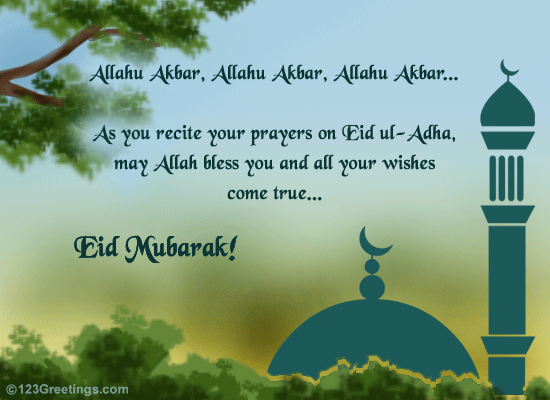I am not a Muslim, but i had strong admiration in Muslim faith. Sacrifice, sharing and charity is the main reason why our Muslim brothers celebrate this day. Very solemn yet enjoys the blessings of Allah.
More blessings, peace and good health to all of you my Muslim brothers!

Here are some ideas why Eid-Al-Adha is one of the major holidays of Islam.
According to Muslim tradition, it celebrates the sacrifice that Abraham was willing to make of his own son Ishmael when he was commanded to show his commitment to Allah. At Allah's direction, the angel Gabriel substituted a lamb for Ishmael, after Allah was convinced that Abraham would indeed sacrifice Ishmael to prove his faith.
On this day, Muslims celebrate in several ways. A large feast is the high point of the day. The name of the holiday, Eid Al-Adha, means "The Feast of the Sacrifice." An animal is sacrificed, in much the same way that Abraham sacrificed a lamb. One-third of the meat is given to the poor, and the rest goes to the holiday feast. Children get gifts to commemorate the holiday, and special prayers are said throughout the day.
Eid Al-Adha takes place on the 10th and last day of the Hajj, the celebration of holy pilgrimage to Mecca, in the 12th month of the Islamic lunar calendar. Muslims the world over are encouraged to make a pilgrimage to Mecca and celebrate.
What does Eid al-Adha commemorate?
During the Hajj, Muslims remember and commemorate the trials and triumphs of the Prophet Abraham. The Qur'an describes Abraham as follows:
"Surely Abraham was an example, obedient to Allah, by nature upright, and he was not of the polytheists. He was grateful for Our bounties. We chose him and guided him unto a right path. We gave him good in this world, and in the next he will most surely be among the righteous." (Qur'an 16:120-121)
One of Abraham's main trials was to face the command of Allah to kill his only son. Upon hearing this command, he prepared to submit to Allah's will. When he was all prepared to do it, Allah revealed to him that his "sacrifice" had already been fulfilled. He had shown that his love for his Lord superceded all others, that he would lay down his own life or the lives of those dear to him in order to submit to God.
Why do Muslims sacrifice an animal on this day?
During the celebration of Eid al-Adha, Muslims commemorate and remember Abraham's trials, by themselves slaughtering an animal such as a sheep, camel, or goat. This action is very often misunderstood by those outside the faith.
Allah has given us power over animals and allowed us to eat meat, but only if we pronounce His name at the solemn act of taking life. Muslims slaughter animals in the same way throughout the year. By saying the name of Allah at the time of slaughter, we are reminded that life is sacred.
The meat from the sacrifice of Eid al-Adha is mostly given away to others. One-third is eaten by immediate family and relatives, one-third is given away to friends, and one-third is donated to the poor. The act symbolizes our willingness to give up things that are of benefit to us or close to our hearts, in order to follow Allah's commands. It also symbolizes our willingness to give up some of our own bounties, in order to strengthen ties of friendship and help those who are in need. We recognize that all blessings come from Allah, and we should open our hearts and share with others.
It is very important to understand that the sacrifice itself, as practiced by Muslims, has nothing to do with atoning for our sins or using the blood to wash ourselves from sin. This is a misunderstanding by those of previous generations: "It is not their meat nor their blood that reaches Allah; it is your piety that reaches Him." (Qur'an 22:37)
The symbolism is in the attitude - a willingness to make sacrifices in our lives in order to stay on the Straight Path. Each of us makes small sacrifices, giving up things that are fun or important to us. A true Muslim, one who submits his or herself completely to the Lord, is willing to follow Allah's commands completely and obediently. It is this strength of heart, purity in faith, and willing obedience that our Lord desires from us.
source:
islam.about.com
www.socialstudiesforkids.com
















